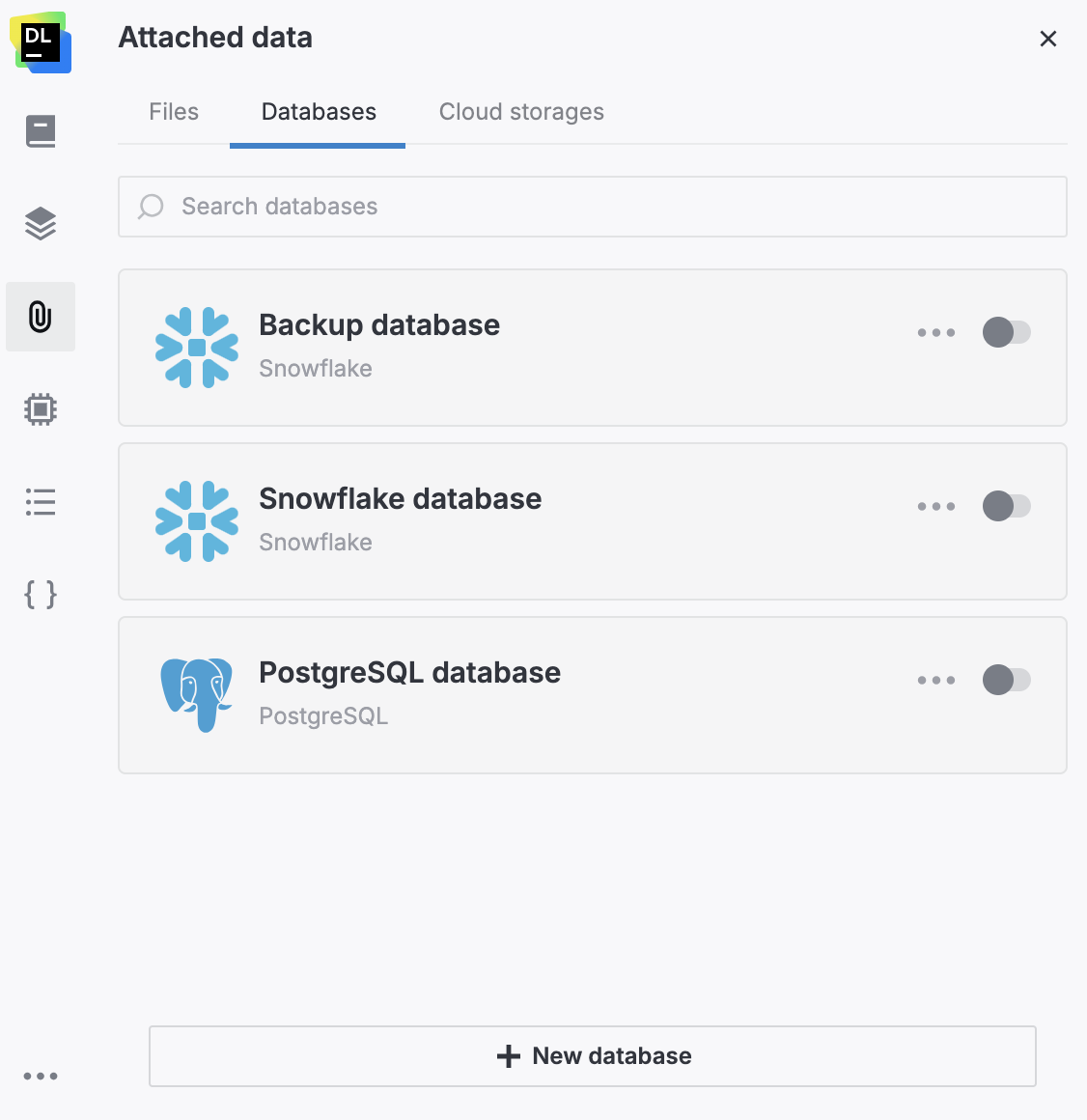Oracle
This procedure explains how to configure an Oracle database connection, including both database types (Oracle and Oracle for 9.X, 10.X, 11.1).
Open the New Oracle connection dialog. Select the tab for one of the two options:
From the editor, to attach the new database to a specific notebook
From the Home page, to add a database connection to a workspace
Notebook/EditorWorkspace/Home pageOpen the Attached data tool from the left-hand sidebar.
Switch to the Databases tab. You will see the list of all database connections available from the respective workspace.
At the bottom of the tab, click New database.

In the New database connection dialog, select Oracle.
On the Home page, select the workspace where you want to create the connection.
In the selected workspace, go to Data | Databases.

Click the Add button in the upper right corner. The New database connection dialog will open.
In the New database connection dialog, select Oracle.

On the General tab, select the connection type.
SID: to connect by using a unique name of an Oracle instance (a process that runs on the workstation).
Service name: to connect by using an alias to an Oracle instance (or many instances).
URL only: to connect by providing the URL of a pre-built connection.
note
Use this method to pass additional parameters. For example, add
&SSL=trueto the URL string to enable SSL.
Proceed based on the selected connection type:
SIDService NameURL onlyIn the Host field, type your server address.
In the Port field, type the port. The default port is 1521.
note
Real port numbers might be different on your system. Verify that you use a correct port number with your database administrator, server settings, or hosting provider.
In the SID field, specify a unique name of an Oracle instance (a process that runs on the workstation).
tip
For the correct value, check the environment variable
ORACLE_SIDon the server host, or contact your database administrator. Commonly-used values are XE or ORCL.From the Driver list, select the Oracle JDBC driver mode to use with your connection:
Thin: the driver connects to the server directly.
OCI and OCI8: the driver uses native libraries to connect to the server.
Under Authentication, select an authentication method:
User & Password: to use your login and password
No auth: to connect without authentication required
In the User and Password fields, specify your credentials if required by the selected authentication method.
In the Host field, type your server address.
In the Port field, type the port. The default port is 1521.
note
Real port numbers might be different on your system. Verify that you use a correct port number with your database administrator, server settings, or hosting provider.
In the Service field, provide the alias to an Oracle instance that you want to use.
From the Driver list, select the Oracle JDBC driver mode to use with your connection:
Thin: the driver connects to the server directly.
OCI and OCI8: the driver uses native libraries to connect to the server.
Under Authentication, select an authentication method:
User & Password: to use your login and password
No auth: to connect without authentication required
In the User and Password fields, specify your credentials if required by the selected authentication method.
Under Authentication, select an authentication method:
User & Password: to use your login and password
No auth: to connect without authentication required
In the User and Password fields, specify your credentials if required by the selected authentication method.
In the URL field, provide the URL of the pre-built connection you want to establish.
(Optional) For other options (SSH tunneling, scope inspection, or additional connection parameters), switch to the respective tab of the dialog and follow one of these procedures.
Click the Test connection button at the bottom of the dialog.
Once the connection is successfully tested, click the Create and close button.
If created for a specific notebook, the new connection will be automatically added to the workspace. You can later attach this database connection to any other notebook from this workspace.
If created for a workspace, this connection is added to the workspace databases and can be attached to any notebook from this workspace.
To retrieve and process data from the connected database, use Query data with SQL cells.
Thanks for your feedback!